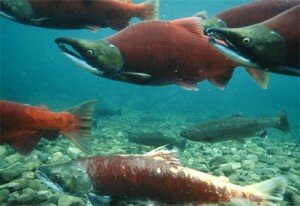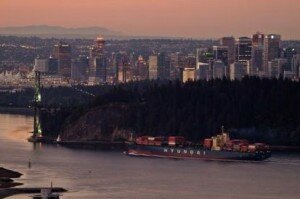 In British Columbia almost two hundred hatcheries pump out over 600 million baby salmon every year. The initial idea was to boost commercial fisheries — double the commercial catch was the intention. Hatcheries and “enhancement” are also intended to compensate for habitat destruction from logging, mining, agriculture, and urbanization. Initial goals and current goals are now all befuddled into a financial melee of over $30 million per year.
In British Columbia almost two hundred hatcheries pump out over 600 million baby salmon every year. The initial idea was to boost commercial fisheries — double the commercial catch was the intention. Hatcheries and “enhancement” are also intended to compensate for habitat destruction from logging, mining, agriculture, and urbanization. Initial goals and current goals are now all befuddled into a financial melee of over $30 million per year.
Some estimates suggest that each hatchery-produced salmon caught in the Strait of Georgia (separates Vancouver Island and the mainland) cost $500 per fish to produce. If that fish is a sockeye it probably averages about 5 pounds, and would fetch less than $1 per pound. That’s a net loss of $495… Any other species would be pennies per pound.
Plus there was Fisheries and Oceans Canada $80 – $100 million “investment” into salmon habitat restoration (for only five years) in the late 1990s, early 2000s. The Habitat Restoration and Enhancement Program (HRSEP). Has anyone taken a look at that “investment” to see what sort of return or loss on investment was amassed?
In Washington, Oregon, Idaho, and California countless hatcheries pump out baby salmon (200 million from Washington State alone) to try and compensate for dams built to produce power, for almost a hundred years of intense logging, and for streams that were obliterated by past mining practices (i.e. California Gold Rush).
On the Columbia River alone — over $6.5 billion have been spent over the last 25 years for fish recovery projects that have been a dismal failure. Historical returns suggest between 10 million and 16 million salmon were the norm — the goal for recovery is approximately 5 million — average returns over the last 30 years are only 2.5 million.
In Alaska, billions of baby salmon are released every year from salmon ranching operations simply to prop up commercial fisheries.The entire Alaskan commercial catch is comprised of anywhere between 35%-45% “ranched” salmon. In areas like Prince William Sound the commercial catch is comprised of 95% ranched salmon.
In Japan, the commercial catch is comprised of 95% ranched salmon.
If you’ve read other posts on this site you have probably seen these numbers a few times. I’m not sure if they can be stated enough.
Yesterday some proceedings from a salmon-related workshop hosted in Vancouver in Feb. 2009 were released. The discussion surrounded how hatcheries and enhanced salmon fit with Canada’s Wild Salmon Policy which suggests “conservation” of wild salmon is the number one priority for how Canadians look after salmon.
The workshop was hosted by Simon Fraser University in Vancouver, British Columbia last year and is part of the “Speaking for the Salmon” project as part of SFU’s Centre for Coastal Studies. The report is titled: “” .
It appears the discussion involved presentations from three experts on the issue. From an outsider looking in, it was a bit like getting excited about reading a book with a good title and finding substance lacking.
And again, I have to point out that I mean no disrespect — these are all experts involved in the presentations and in putting the report together. And by no means do I have the answers – simply pointing out my personal disappointment in hearing many of the same things over, and over, and over, and over…
Such as: “we need more dialogue….” and “we need more science…” and “we need government departments to get along…”
One presentation suggests that the 30+ years Salmon Enhancement Program has been nothing more than an “operational” program with little to no research or accountability measures. There has been little scientific investment and more funding for science is required before any conclusions are made.
Another presentation suggests that we may need one giant experiment with cooperation between all nations pumping baby salmon out into the North Pacific (although Japan wasn’t mentioned). Plus a brief suggestion that maybe a seal cull program could assist in the Georgia Strait.
“If the experiment fails, then the seals ate them all. The current harbour seal population could eat all the coho pumped into the Strait in 12 days. Seal populations are like a huge fishery.”
 Last time I checked the population of Vancouver could have eaten the entire Fraser River salmon return this past year in one day of breakfast, lunch and dinner… (And that overfishing by humans is what got us into this predicament)
Last time I checked the population of Vancouver could have eaten the entire Fraser River salmon return this past year in one day of breakfast, lunch and dinner… (And that overfishing by humans is what got us into this predicament)
Another presentation spoke of Washington State’s experience with hatcheries and how new scientific models are trying to separate wild from domesticated (hatchery) salmon stocks.
Although the model is well-grounded in theory, application of the approach is so new that model predictions have not yet been experimentally verified.
Hmmm.
The conclusions of the workshop proceedings:
“Ongoing dialogue will be crucial, involving not just the public and stakeholders, but also various government agencies and sectors within DFO [Fisheries and Oceans Canada].”
“Without meaningful engagement between the federal and provincial governments regarding WSP [Wild Salmon Policy] implementation, the objectives of the WSP will not be met”
“Diminishing government capacity and resources will present a mounting challenge to multi-agency engagement and coordination and this can only be met by creative and forward-thinking solutions with public and political support.”
Having some background in running my own businesses — if we ran businesses with these sort of “experiments” with no accountability, interventions with little follow-up, and black hole funding and subsidy schemes that have plagued salmon management for the last fifty years — there is no way in bloody hell the business would exist for more than a month.
If we then considered taking the company “public” there is not a hope on the planet that we could interest investors.
So, why does the general public put up with this? — it is, after all, a public resource.
Granted, the particular report I reference is not the issue — it just points to some of the symptoms. Maybe there are too many scientists and not enough business-minded folks; maybe too many fish counters and not enough general practitioners; maybe too many “non-profit” experts and not enough provocateurs.
I have in a suggested maybe a Citizen’s Assembly on par with the Assembly that approached electoral reform in British Columbia.
